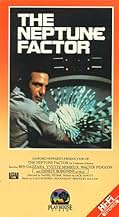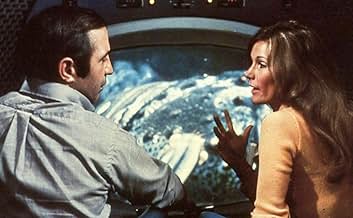NOTE IMDb
4,4/10
1,4 k
MA NOTE
Ajouter une intrigue dans votre langueWhen an underwater ocean lab is lost in a earthquake, an advanced submarine is sent down to find it and encounters terrible danger.When an underwater ocean lab is lost in a earthquake, an advanced submarine is sent down to find it and encounters terrible danger.When an underwater ocean lab is lost in a earthquake, an advanced submarine is sent down to find it and encounters terrible danger.
- Réalisation
- Scénario
- Casting principal
- Récompenses
- 1 nomination au total
Ken Pogue
- Diver Thomas
- (as Kenneth Pogue)
Avis à la une
An earthquake under the ocean floor hits a lab on the seabed. As a result, it's umbilical cord to the surface ship is severed and the lab tossed over a sheer underwater cliff. Now it is so deep that conventional divers cannot reach it, so the only hope is a deep water submersible, the Neptune.
Despite the film being about an ocean disaster, it's amazing just how static and dull the movie is. I think the main problem is pacing...not acting, as the actors are generally a very accomplished group of professionals. Too often, the director chose to portray the film in the least exciting manner....and I had to really struggle to pay attention or even to care.
By the way, although I don't recommend anyone see this movie, scuba divers might enjoy watching some of the diving sequences...especially when the DIve Master is thrashing about in the water like he just got his certification yesterday!
Despite the film being about an ocean disaster, it's amazing just how static and dull the movie is. I think the main problem is pacing...not acting, as the actors are generally a very accomplished group of professionals. Too often, the director chose to portray the film in the least exciting manner....and I had to really struggle to pay attention or even to care.
By the way, although I don't recommend anyone see this movie, scuba divers might enjoy watching some of the diving sequences...especially when the DIve Master is thrashing about in the water like he just got his certification yesterday!
The Neptune Factor deals with some scientists who live and work out of an undersea lab in the Atlantic Ocean. One fine day while their bosses, Walter Pidgeon, Yvette Mimieux, and Ernest Borgnine are up top, an earthquake occurs and the lab topples over into an underwater crevice.
Though an atomic power submarine could stay down there indefinitely the problem is that crevice is way too small for one of those big boys. A smaller type submarine able to withstand the pressures of the very deep is needed and that's where Ben Gazzara and his ship the Neptune come in.
As disaster films go The Neptune Factor is small potatoes special effects wise. It's a Canadian production and I've seen Hollywood come up with worse films spending a ton more money than was done here.
The special effects such as they are, are merely movie films of some ordinary species of marine life blown up several times their size, because these are the creatures the crew finds down at depths that man hasn't been before. It's beautiful undersea photography just like a trip to Marineland.
It's a no frills production, no subplots of any kind, no social interaction of any kind with the crew, just do the mission and go home. That's why it was given a G rating when first released.
If you love Jacques Cousteau, you'll love this film.
Though an atomic power submarine could stay down there indefinitely the problem is that crevice is way too small for one of those big boys. A smaller type submarine able to withstand the pressures of the very deep is needed and that's where Ben Gazzara and his ship the Neptune come in.
As disaster films go The Neptune Factor is small potatoes special effects wise. It's a Canadian production and I've seen Hollywood come up with worse films spending a ton more money than was done here.
The special effects such as they are, are merely movie films of some ordinary species of marine life blown up several times their size, because these are the creatures the crew finds down at depths that man hasn't been before. It's beautiful undersea photography just like a trip to Marineland.
It's a no frills production, no subplots of any kind, no social interaction of any kind with the crew, just do the mission and go home. That's why it was given a G rating when first released.
If you love Jacques Cousteau, you'll love this film.
5JHC3
Oceanlab is an experimental station built atop an undersea mountain in the
North Atlantic somewhere off the coast of Canada. An earthquake strikes,
causing the lab to plunge into an unexplored abyss. Three men are trapped
aboard and they have only seven days of oxygen remaining.
After five days, the Oceanlab team is able to call in a retired naval officer, Commander Blake (Gazzara). Using his deep sea submersible "Neptune II," it
is hoped he can locate and rescue the men before they suffocate. The hope is a slim one; all contact with the lab was lost when the earthquake occurred. The submersible must face the hazards of deep sea travel, aftershocks, and some
very unexpected discoveries on the ocean floor.
The cast is unusually strong with Ernest Borgnine, Donnelly Rhodes, Yvette
Mimieux, and Walter Pigeon all putting in good performances. The special
effects are limited to model work for undersea shots, but the models are decent enough given the year of release. The film starts out well with the opening
score being particularly noteworthy. Unfortunately, once the submersible gets in the water, the viewer is taken for a rather dull ride for the bulk of the film. Suspense is largely absent. In lieu of pacing, the filmmakers subject the viewer to a lot of stock fish footage. While this was decent enough, it was overused and probably better suited to a nature documentary. Ultimately, the screenplay
needed some serious work. There is insufficient substance to make this work
even as a one hour Twilight Zone or Outer Limits episode. "The Neptune
Factor" otherwise possessed all of the elements necessary to make a successful and compelling adventure film.
North Atlantic somewhere off the coast of Canada. An earthquake strikes,
causing the lab to plunge into an unexplored abyss. Three men are trapped
aboard and they have only seven days of oxygen remaining.
After five days, the Oceanlab team is able to call in a retired naval officer, Commander Blake (Gazzara). Using his deep sea submersible "Neptune II," it
is hoped he can locate and rescue the men before they suffocate. The hope is a slim one; all contact with the lab was lost when the earthquake occurred. The submersible must face the hazards of deep sea travel, aftershocks, and some
very unexpected discoveries on the ocean floor.
The cast is unusually strong with Ernest Borgnine, Donnelly Rhodes, Yvette
Mimieux, and Walter Pigeon all putting in good performances. The special
effects are limited to model work for undersea shots, but the models are decent enough given the year of release. The film starts out well with the opening
score being particularly noteworthy. Unfortunately, once the submersible gets in the water, the viewer is taken for a rather dull ride for the bulk of the film. Suspense is largely absent. In lieu of pacing, the filmmakers subject the viewer to a lot of stock fish footage. While this was decent enough, it was overused and probably better suited to a nature documentary. Ultimately, the screenplay
needed some serious work. There is insufficient substance to make this work
even as a one hour Twilight Zone or Outer Limits episode. "The Neptune
Factor" otherwise possessed all of the elements necessary to make a successful and compelling adventure film.
Not as exciting as the box cover artwork might suggest, with a painfully stilted characterisation by Ben Gazzara and capable supporting cast trapped in one-dimensional roles. The story concerns militant, officious salvage expert (Gazzara) contracted by an aquatic research team to recover a stricken underwater manned probe that has descended into a deep sea ravine. Gazzara makes it clear from the outset that his goal is only to locate the vessel for insurance purposes, except Mimieux's companion is one of those aboard and she ups the ante in spite of escalating challenges.
Pidgeon and Borgnine have little opportunity to establish any characterisation, while Mimieux simply frets and affects anxiety to demonstrate her 'depth' of character. The friction between her and Gazzara is about the only palpable action in the whole picture. The special effects consist of intense magnification of gold fish and other aquarium species, while endless jolts and turbulence puts you in the environmental context. As far as dialogue goes, the technical spec consists mainly of references to rudder malfunction and oxygen saturation. Riveting stuff.
Disappointingly, the film ends abruptly where it could have developed a more convincing, compelling climax. After waiting 95 minutes, the audience is treated to a Jules Verne moment in which 'giant' eels corral the probe's survivors as they run out of oxygen. But just as the action gains momentum, the film ends. Five more minutes of that encounter might have earned another star, but this underwater adventure is mostly talk and no action.
Pidgeon and Borgnine have little opportunity to establish any characterisation, while Mimieux simply frets and affects anxiety to demonstrate her 'depth' of character. The friction between her and Gazzara is about the only palpable action in the whole picture. The special effects consist of intense magnification of gold fish and other aquarium species, while endless jolts and turbulence puts you in the environmental context. As far as dialogue goes, the technical spec consists mainly of references to rudder malfunction and oxygen saturation. Riveting stuff.
Disappointingly, the film ends abruptly where it could have developed a more convincing, compelling climax. After waiting 95 minutes, the audience is treated to a Jules Verne moment in which 'giant' eels corral the probe's survivors as they run out of oxygen. But just as the action gains momentum, the film ends. Five more minutes of that encounter might have earned another star, but this underwater adventure is mostly talk and no action.
Not a bad effort, really, given that the film was made during the age of Cousteau. Underwater filming of deep ocean life had not been accomplished. Now we know what it looks like way down there, so the fish tank 'special effects' really ruin the story. The first sight of a clown fish is like a slap in the face! The film becomes a comedy after that! But really, this is only because science education (as miserable as it may be) has advanced SO MUCH on television. Now we can sit on our sofa and watch animal planet to get a better seminar on deep ocean life than marine biologists of the day received! So, if you're looking for a top-notch special effects masterpiece, the toy sub floating in the Monterey Bay aquarium's fish tanks probably won't cut it. Nevertheless, it's an entertaining few minutes, anyway. I say, watch it and try to forget about reality for a while. Pretend you're TEN!
Le saviez-vous
- AnecdotesProducer Sandy Howard consulted a large number of marine biologists, oceanographers, and ichthyologists two years prior to taking the script into production.
- GaffesNeptune's crew was able to watch through the submarine's glass window all the objects and fish around them under sunlight although they were deeper than 300 meters from the sea surface. Sunlight is barely seen in the sea bottom at depths greater than 200m.
- Citations
Dr. Leah Jansen: And those jawfish! The ones I've seen have been only two inches long. Look at them!
- ConnexionsReferenced in Contre une poignée de diamants (1974)
Meilleurs choix
Connectez-vous pour évaluer et suivre la liste de favoris afin de recevoir des recommandations personnalisées
Détails
- Date de sortie
- Pays d’origine
- Langue
- Aussi connu sous le nom de
- The Neptune Disaster
- Lieux de tournage
- Sociétés de production
- Voir plus de crédits d'entreprise sur IMDbPro
Box-office
- Budget
- 2 500 000 $CA (estimé)
Contribuer à cette page
Suggérer une modification ou ajouter du contenu manquant
































